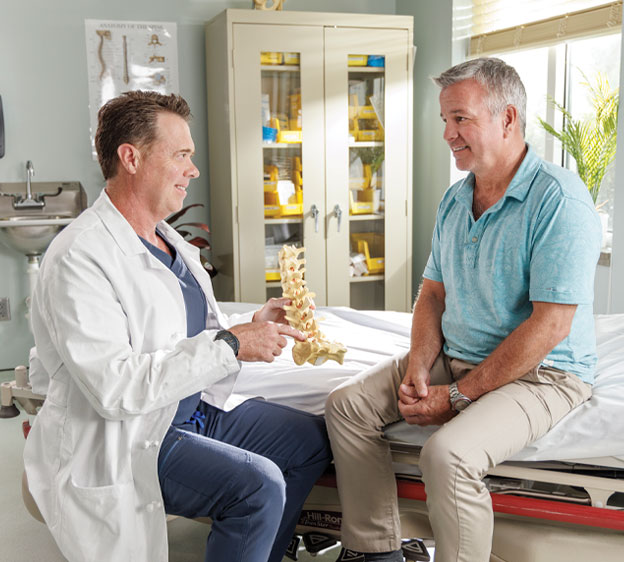
When wear and tear or traumatic injury puts excessive pressure on your spinal cord, you have spinal compression. To find healing, spinal decompression surgery may be necessary.
“Spinal compression can cause minor pain or leave you unable to walk or function,” says Dr. Andrew Castro, board-certified orthopedic spine surgeon with the Beaufort Memorial Advanced Orthopedics and Spine Program. “Getting it treated quickly and properly lets you get back to life.”
Understanding the Spine
Your spine is made of 33 vertebrae (bones) that help you stand and sit upright and move in different directions. Your spinal cord runs down your spine through a hollow opening called the spinal canal. Nerves go out from the spinal cord and connect your brain to your body, helping you move and allowing you to feel various sensations. The spinal canal protects your spinal cord from injury.
Between most vertebrae are cartilage-covered spinal discs. These discs allow your spine to bend. They also help absorb shock when you move.
Conditions Surgeons Can Treat With Spinal Decompression
Spinal decompression can address many conditions that place pressure on the spinal cord or nerves coming off of it. Conditions that cause spine compression include:
- Cervical spondylotic myelopathy. This type of nerve compression occurs in the neck, often as a result of a herniated disc, rheumatoid arthritis, normal aging or bone growths called bone spurs. Symptoms include arm or neck pain, numbness in the arms or legs, bowel and urinary incontinence, and difficulty walking.
- Herniated disc. Over time, your spinal discs wear out (degenerate), and the soft, gel-like centers can push outward, creating pressure on your spinal cord and nerves. Depending on the location of your herniated disc, you may notice pain, burning, numbing or tingling anywhere from your neck and back to your feet.
- Spinal stenosis. “Stenosis” means “narrowing,” and in spinal stenosis, your spinal canal narrows, putting pressure on the nerves inside the spinal cord. Spinal stenosis can also reduce space in the area where nerves leave the spinal cord. Spinal stenosis is most common the lumbar spine (lower back) and cervical spine (neck). You may have neck or lower back pain; weakness in the legs, feet, hands or fingers; numbness; or a burning, radiating pain in your buttocks and legs.
Read More: Put Your Back Into It: Spinal Stenosis Exercises
How Spinal Decompression Surgery Helps Relieve Pain
There are a few types of surgery that allow your surgeon to address the underlying cause of narrowing or address symptoms caused by a degenerated disc.
“The right spinal decompression surgery can relieve symptoms, such as back pain, leg pain, weakness and numbness, associated with these conditions,” Dr. Castro says. “We work with patients to find the right procedure for their needs, based on the cause of their pain and the extent of the damage to their vertebrae, discs and nerves.”
Depending on your needs, spinal decompression surgeries your provider may recommend include:
- Artificial disc replacement. A surgeon removes the herniated disc and puts an artificial disc in its place. The artificial disc may be plastic and metal or only metal. This procedure takes pressure off nerves in the spinal cord. In the right situation, it provides significant improvement for pain and other symptoms.
- Discectomy. The surgeon makes a small hole in a herniated disc and removes the soft substance pushing against the spine’s nerves. Your surgeon may remove other fragments of the disc as well.
- Foraminotomy. Nerves travel from the spinal cord to the rest of your body. Sometimes, bone spurs can develop in the openings through which these nerves travel, causing the space to narrow. In a foraminotomy, your surgeon removes the bone spurs, giving the nerve more space and helping your symptoms.
- Laminectomy. The back part of the spinal canal is made of lamina bones. In a laminectomy, your surgeon removes these bones, increasing the size of the spinal canal and relieving pressure on the nerves traveling through it. Your surgeon may also remove other bones or discs causing problems. You should experience full or partial relief from symptoms and return to basic daily activities, such as driving, after four weeks.
- Spinal fusion. The surgeon typically takes a small piece of bone or bone material and connects it to the vertebrae causing symptoms. This surgery prevents movement in the treated vertebrae. Because your vertebrae can’t move, they cannot compress nerves or discs.
Nonsurgical Treatments for Spine Compression
Some spinal compression requires immediate surgery. However, you may benefit from other treatment methods.
Read More: Help for Back and Neck Pain: Is Surgery Always Necessary?
Nonsurgical treatments include:
- Physical therapy. A physical therapist can teach you special exercises that strengthen abdominal and back muscles, which can help support your spine. Therapy can also help you maintain range of motion and mobility, which may allow you to perform daily activities with less pain.
- Medication. Compression in the spine can cause inflammation and pain. Over-the-counter or prescription medications can provide significant improvement of symptoms. In some cases, your provider may recommend a steroid injection to reduce inflammation and improve other symptoms.
- Lifestyle changes. Minor pain may resolve with weight loss and quitting smoking. Small tweaks to your daily routine, such as limiting activities that cause or worsen symptoms can also help.
- Bracing. In limited situations, wearing a brace can help stabilize your spine and reduce symptoms. Braces are particularly helpful as you age or develop weakened abdominal muscles, according to the National Institute of Arthritis and Musculoskeletal and Skin Diseases. A neck brace may help with neck pain.
Learn more about spinal surgery at Beaufort Memorial or request an appointment with a spine surgeon.

